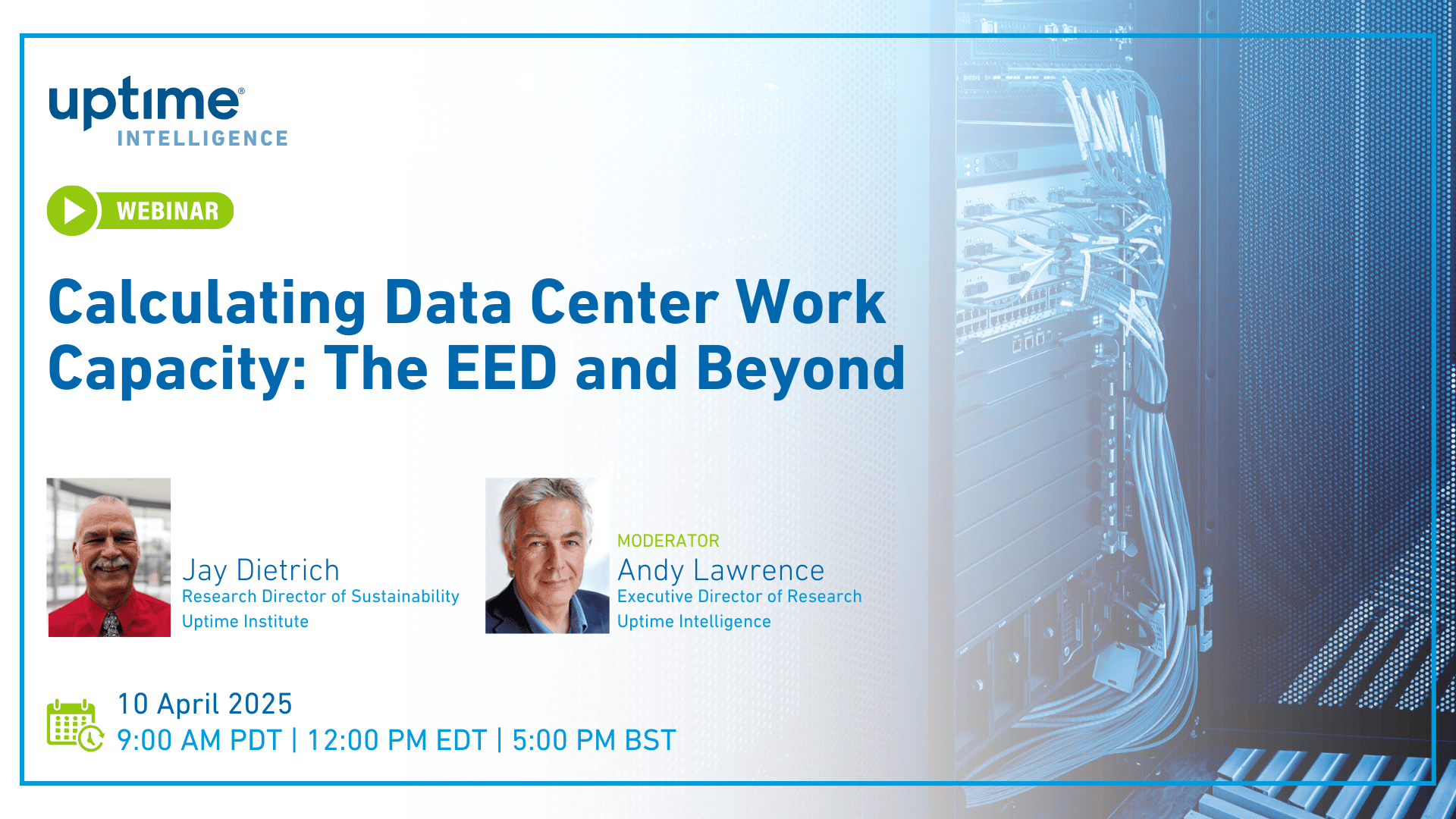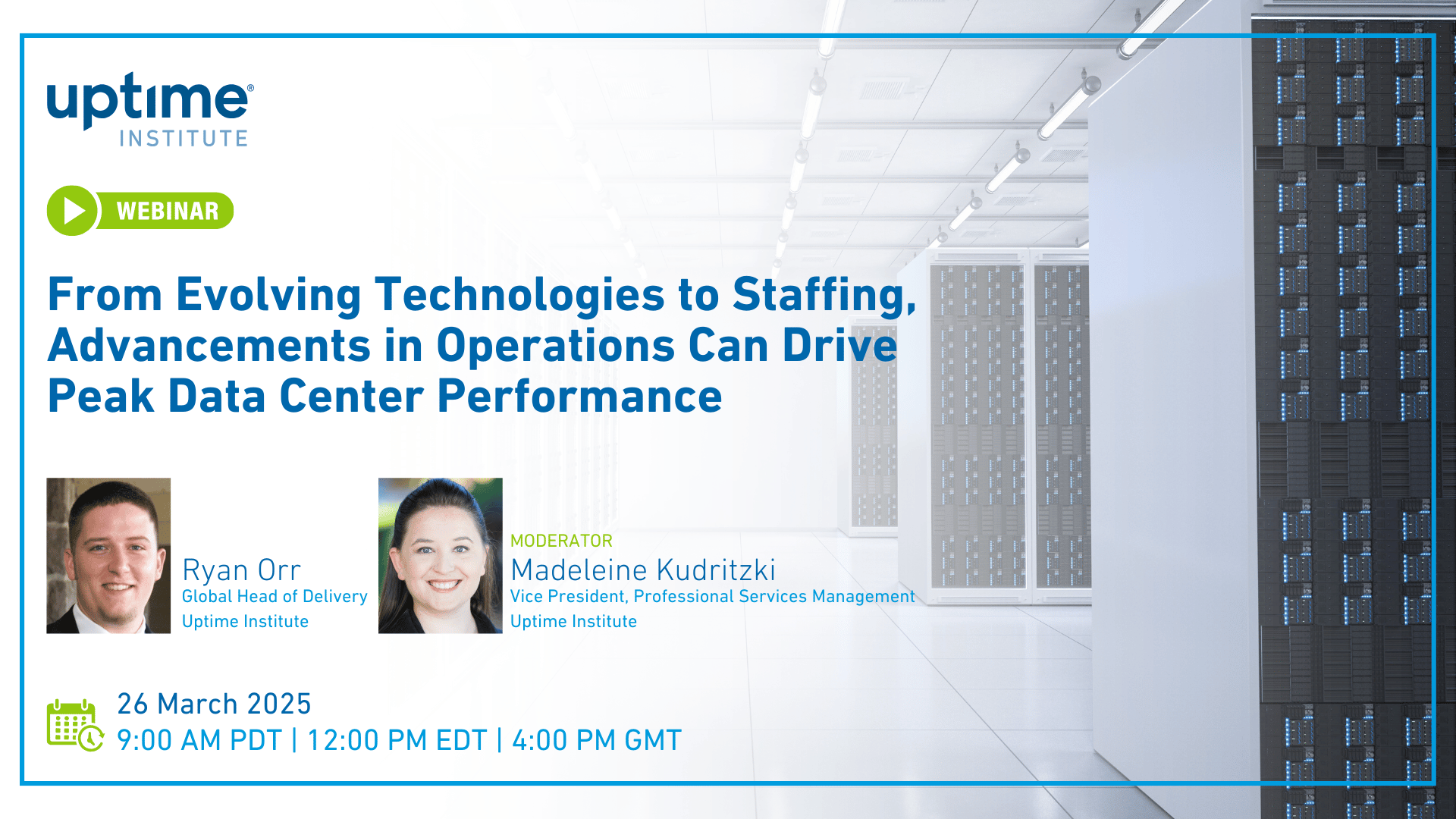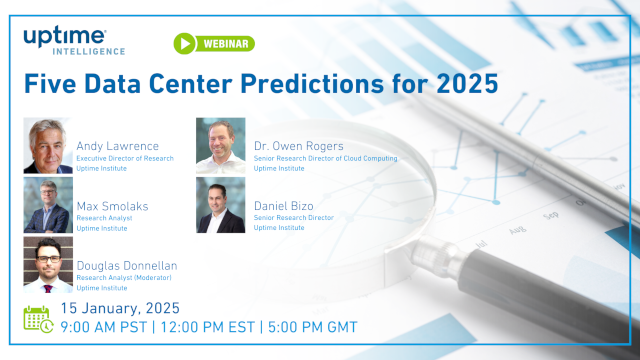Webinaire: 2019 Résultats de l’enquête sur l’industrie des datacenters
Titre de la présentation :
Résultats de l’enquête Uptime Institute 2019 sur l’industrie des datacenters
Présentateurs :
Andy Lawrence, Directeur exécutif, Recherche
Rhonda Ascierto, Vice-présidente, Recherche
Christopher Brown, Directeur technique
Résumé :
Les résultats les plus importants et les plus influents de l’industrie des datacenters sont arrivés. Rejoignez-nous pour découvrir les tendances. Les centres de données sont-ils plus efficaces ? Comment les pannes changent-elles ? Quelle proportion des charges de travail sont exécutées dans le cloud ? La densité des racks augmentera-t-elle enfin ?
| Question du public | Réponse Uptime Institute |
|---|---|
| Les chiffres indiquent que le PUE ne s’est pas amélioré récemment, mais la densité des racks augmente. Je suppose qu’une plus grande densité de racks améliorerait le PUE. Des réflexions à ce sujet ? | En théorie, une augmentation de la densité du rack entraînerait une augmentation de la température de l’air de retour, ce qui entraînerait une augmentation de la température différentielle côté air et pourrait entraîner un fonctionnement plus efficace des systèmes de refroidissement. Cependant, dans la pratique, je n’ai pas vraiment vu cela fonctionner parce qu’il y a tant de choses avec la conception qui entre en jeu, par exemple, y a-t-il un confinement pour limiter l’alimentation et le retour d’air, ainsi que la manière dont le système électrique fonctionne pour réellement entraîner une diminution du PUE. |
| 1. Qu’en est-il des mesures basées sur l’efficacité : Efficacité de l'infrastructure du datacenter (DCiE) 2. Également des mesures basées sur les ressources : - Intensité carbone (CUE) - Utilisation de l’eau (WUE) |
En tant qu’humains, nous aimons les indicateurs. Ils peuvent être mesurés et signalés automatiquement. Ce sont de bons indicateurs de performance tant que les indicateurs utilisés sont adaptés au centre de données individuel et aux besoins et désirs de l’entreprise. Par exemple, si un centre de données est situé dans un endroit où l'eau potable est abondante et où la surveillance est peu coûteuse, le WUE peut indiquer dans quelle mesure il utilise l'eau pour l'environnement, mais peut ne pas avoir beaucoup d'importance pour les coûts globaux du centre de données. C'est la raison pour laquelle j'ai mis en garde contre l'utilisation du PUE comme mesure de l'efficacité du datacenter, car il peut montrer une opération efficace, mais d'autres mesures peuvent montrer une surconsommation d'énergie ou d'actifs informatiques qui entraîne des coûts d'exploitation plus élevés. Il est important de toujours garder à l’esprit les objectifs de l’entreprise en matière d’efficacité. |
| Que définissez-vous comme des charges critiques ? | Les datacenters sont conçus pour répondre à un besoin commercial. Les charges critiques sont les charges nécessaires à l’exploitation de l’entreprise et sans lesquelles l’entreprise serait affectée négativement, voire arrêtée. |
| Quelle est votre définition de « Entreprise » ? | Je pense que vous faites référence à notre utilisation du terme « Enterprise Data Center ». Dans ce cas, un centre de données d'entreprise est un centre de données détenu par une entreprise pour répondre à ses propres besoins informatiques. Elle n'est pas basée sur la taille de l'entreprise, mais simplement sur le fait que le centre de données appartient à l'entreprise et est utilisé pour répondre à ses propres besoins informatiques. |
| Selon vous, qu’est-ce que les entreprises, les centres de distribution, les sociétés Colo et leurs acteurs clés au sein du centre de distribution avec la virtualisation et la consolidation traditionnelles doivent entendre pour devenir (plus) ouverts à l’apprentissage machine/l’analyse prédictive qui pourraient avoir un impact positif sur leur infrastructure électrique et potentiellement augmenter la densité de leurs racks et améliorer leur infrastructure électrique. | L’enquête annuelle mondiale 2018 de l’Uptime Institute a montré que 70 % des fournisseurs, consultants et fournisseurs interrogés pensent que l’IA sera largement utilisée dans les centres de données. La complexité et l'échelle des datacenters modernes, associées à la rapidité de changement dans les environnements informatiques, deviennent trop importantes pour être gérées efficacement par les humains. Cependant, pour les ordinateurs et l’intelligence artificielle, cela peut être relativement simple. Un objectif clé est de prévoir et de prévenir les incidents, ainsi que de détecter et de remédier aux inefficacités et aux insuffisances de capacité. Étant donné que de nombreux centres de données sont utilisés de manière sous-optimale, de nombreux opérateurs sont susceptibles de bénéficier de la technologie. |
| Vous mentionnez que les réseaux sont la deuxième raison principale des temps d’arrêt. Quel est le problème ? S’agit-il d’un problème de qualité des équipements que les fabricants d’équipements réseau fournissent ? |
Dans cette enquête et d’autres recherches, Uptime Institute a constaté une nette augmentation des défaillances dues aux incidents de réseautage. Les données suggèrent également que les perturbations liées aux technologies de l’information/au réseau peuvent prendre plus de temps à réparer que les interruptions des installations d’alimentation/de datacenter. |
| Étant donné que 12 % de vos répondants provenaient de services logiciels/cloud, 16 % de télécommunications et 26 % de Colo/multi-locataire, pensez-vous que la discussion sur le cloud doit être plus nuancée ? Un fournisseur de services de colocation répondant à la question « Où plaçons-nous les charges de travail critiques » ne répond pas de la même manière que les entreprises interrogées. Cela a peut-être déjà été pris en compte ? | Oui, notre analyse approfondie est plus nuancée. Au cours du webinaire, nous n’avons partagé qu’un échantillon des points de données principaux. Des résultats d’enquête plus détaillés et l’opportunité de discuter directement des résultats avec le personnel d’Uptime Institute Intelligence sont disponibles pour les membres d’Uptime Institute Network. |
| Quelles techniques sont disponibles pour gérer de manière proactive les performances et l’efficacité ? | Les approches DCIM, DMaaS et autres approches basées sur l’IA sont toutes d’excellents moyens de gérer de manière proactive les performances et l’efficacité. |
| Bien que la question de la résilience soit clairement une préoccupation majeure et que les défis persistent, pensez-vous que les dirigeants se penchent également sur l'aspect de l'utilisation des actifs du datacenter alors qu'ils font d'autres ressources dans leur entreprise, physiques ou humaines ? | Oui, bien qu’il ne soit pas rare que les dirigeants acceptent de faibles taux d’utilisation des actifs du datacenter comme compromis pour une résilience élevée ou la gouvernance du contrôle/des données qui accompagne la possession d’un établissement privé. Dans les installations privées et tierces, telles que la colocation, il est également courant que les taux d’utilisation ne soient même pas suivis. Cependant, nous commençons lentement à voir davantage de centres de données adopter des approches de puissance définies par logiciel qui permettent une utilisation plus élevée des actifs (via le transfert/le délestage de charge et/ou avec des accords transactifs avec les services publics locaux). Les ressources humaines sont, de manière générale, en pénurie dans l’ensemble du secteur. Une faible utilisation n’est pas un problème dont nous entendons parler. |
| Sur la diapositive concernant : manque de compétences dans le centre de données, le personnel de la fonction forçante a-t-il un approvisionnement ou un budget organisationnel ? D’après le langage des « coupes », cette diapositive est-elle susceptible d’être une attente de la direction en termes d’effets d’automatisation et de poursuite de ces opportunités ? | Ce que nous entendons à plusieurs reprises dans tout le secteur, c’est que l’approvisionnement en personnel est la fonction de forçage. Ceci est particulièrement préoccupant compte tenu du grisage du secteur. Les réductions de personnel sont souvent le résultat du passage de centres de données privés sur site à des installations tierces, telles que la colo et le cloud. Cependant, même les hyperscalers ont du mal à pourvoir les postes vacants. En termes d’automatisation, nous n’avons posé que des questions sur l’IA (prochement liée). Während der Patentzeit darf kein anderes Unternehmen das gleiche Produkt auf den Markt bringen. Wo kann ich beide Medikamente beantragen. Die Dauer der Wirkung beträgt zwischen 24 und 36 Stunden. Durch das cGMP erschlaffen die glatten Muskelzellen im Schwellkörper. Solche patentierten Präparate Potenzmittel Kamagra 100 mg ohne Rezept sind recht kostspielig und manchem Verbraucher viel zu teuer. Schwerverdauliches Essen kann die Wirkung abschwächen. Wie wirken die Medikamente für die Beseitigung der erektilen Dysfunktion. En réponse à la question, pensez-vous que l’intelligence artificielle (IA) réduira les niveaux de dotation en personnel de vos opérations de datacenter au cours des 5 prochaines années ? 29 % ont répondu oui, 42 % ont répondu oui, mais dans plus de 5 ans, et 29 % ont répondu non. De manière générale, l’IA et l’automatisation sont des objectifs à court ou moyen terme pour de nombreux opérateurs de datacenters. |
| Comment définissez-vous la « panne » ? | De manière générale, nous définissons une panne comme une interruption de service. Dans cette définition large, nous évaluons également les pannes spécifiques en fonction de l’impact de la panne. Nous définissons ces évaluations plus en détail dans le tableau d’évaluation de la gravité des pannes de l’Uptime Institute ici :https://uptimeinstitute.com/resources/outage-severity-rating |
| Vous avez des questions sur le webinaire ? Envoyez-nous un e-mail à l’ info@uptimeinstitute.comadresse | |





